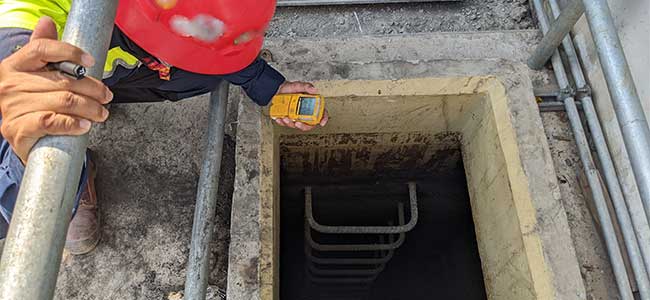
Breathing Easier: The Crucial Role of Gas Detection in Confined Space Entry
Effective gas detection and a comprehensive confined space entry plan are crucial for ensuring worker safety and preventing fatalities in hazardous environments.
- By Dante Moore
- Jun 11, 2024
Every year, industrial workers around the globe face the daunting task of entering confined spaces to perform necessary inspections, maintenance and operations. These spaces—characterized by their limited openings not designed for continuous occupancy—present a variety of hazards, most of which are invisible, odorless and potentially lethal gases.
Confined spaces are breeding grounds for silent killers: noxious, hazardous gases. Without adequate ventilation, gases such as hydrogen sulfide, carbon monoxide, methane and others can accumulate to toxic levels. Moreover, oxygen-deficient environments pose a significant risk of suffocation, especially on immediate entry.
When it comes to confined spaces, it’s not just about detecting the presence of hazardous gases. It’s about doing so in a way that is reliable, accurate and timely.
Gas Detection: Your First Line of Defense
The significance of gas detection can’t be overstated. In confined space work, the margin for error is slim, and the consequences of oversight are grave. Safety regulations—such as those stipulated by the Occupational Safety and Health Administration (OSHA)—mandate the monitoring of atmospheric hazards as part of a confined space program.
These regulations are born out of a history of unfortunate incidents, where both workers and would-be rescuers have succumbed to the perils of unsafe environments. Compliance is not just a legal obligation; it is a moral imperative to protect human life.
From portable, personal gas detectors and area monitors to robust live monitoring software, workers should rely on tools tailored to meet the safety demands of confined space entry. By utilizing multi-gas monitors and area monitors that share not only real-time gas readings but also man-down alarms and panic alerts, both nearby peers and safety personnel can mitigate hazards before an evacuation is even needed. When combined with live monitoring software, users can also take advantage of a variety of sensor options that can be configured to cover any and every confined space hazard they may face.
Most importantly, shared readings can help eliminate up to 60 percent of confined space would-be rescuer deaths by informing rescuers—before they enter—why their peer is in danger. This creates a safety culture where workers know someone’s always got their back, even in the most dangerous working conditions.
However, this is all easier said than done. So how does one go about creating an effective safety culture around confined space entry?
Creating a Confined Space Entry Plan
A well-rounded confined space entry plan—including setting up the right confined space monitor—is critical to minimize risk.
Planning for confined spaces can help prevent unnecessary incidents and reduce the risk of injury or death. No two confined spaces are the same. So prior to entry, it is essential to examine each space for risk and hazard assessments, choose the right confined space monitor based on entry requirements and train workers.
Confined Space Testing Best Practices
Regulations generally require testing the atmosphere within a confined space with a direct-reading monitor before a person enters. This is commonly performed with a confined space monitor equipped with a remote sampling pump, which allows the user to see not only if the space is safe but also how safe.
Although testing after that is only required before re-entry, it’s safest to continuously monitor for atmospheric hazards because conditions can change within moments, leaving workers unaware of danger. Area monitors are helpful for continuous monitoring because of their long battery life and easy set-up. Simply turn the monitor on and place it in the confined space to ensure that you always have visibility into the gas readings.
Quickly Communicate Working Conditions
Communication is a major factor in protecting workers in confined spaces. Attendants are required to monitor the areas and the status of the workers within them. However, because of ever-changing conditions and loud environments, it can be a challenge for attendants and peers to understand the status of entrants.
For example, conditions within a confined space can change rapidly, and what was once a safe environment can quickly become hazardous due to the processes taking place within or near the space. With peer-to-peer connected gas monitors, alarms for gas hazards, immobility or other safety emergencies are instantly shared to peers and the attendant, enabling a quick and effective response.
Additionally, safety teams can take this a step further by implementing a live monitoring solution. Live monitoring allows anyone anywhere to be alerted when gas hazards put workers in danger so that everyone can respond accordingly.
Your Guardian Against the Unseen
Overall, the role of gas detection in confined space entry can’t be overemphasized. Each year, the technology and expertise provided by gas detection companies can help avert countless potential disasters, save lives and promote a culture of safety that resonates throughout the industry.
Personal, multi-gas monitors, area monitors and live monitoring software are not merely tools to get the job done; they’re guardians against the unseen. They allow your workers to enter confined spaces with confidence and emerge safely, ensuring everyone goes home to their families at the end of the day and that everyone can breathe a little easier knowing they’re safe.
This article originally appeared in the June 2024 issue of Occupational Health & Safety.